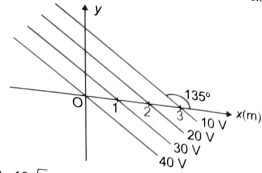The figure shows a set of equipotential surfaces. The magnitude and direction of the electric field that exists in the region are:

1. V/m at with x-axis
2. V/m at with x-axis
3. V/m at with x-axis
4. V/m at with x-axis

Determine the electric field strength vector if the potential of this field depends on x, y coordinates as V=10axy.
1.
2.
3.
4.
If on the x-axis, the electric potential decreases uniformly from 60 V to 20 V between x=-2 m to x=+2 m, then the magnitude of electric field at the origin:
1. must be 10 V/m.
2. may be greater than 10 V/m.
3. is zero.
4. is 5 V/m.
An infinite conducting sheet has a surface charge density . The distance between the two equipotential surface is r. The potential difference between these two surfaces is:
1.
2.
3.
4.
Two small spheres each carrying a charge q are placed at distance r apart. If one of the spheres is taken around the other in a circular path, the work done will be equal to:
1. Force between them r
2.
3. Force between them
4. Zero
Work done in moving a charge q coulomb on the surface of a given charged conductor of potential V is:
1. joule
2. joule
3. joule
4. Zero
If an -particle and a proton are accelerated from rest by a potential difference of 1 megavolt, then the ratio of their kinetic energies will be:
1.
2. 1
3. 2
4. 4
Three charges -q, Q and -q are placed respectively at equal distances on a straight line. If the potential energy of the system of three charges is zero, then what is the ratio of Q:q?
1. 1: 1
2. 1: 2
3. 1: 3
4. 1: 4
A particle A has charge +q and another particle B has charge +4q with each of them having the same mass m. When allowed to fall from rest through the same electric potential difference, the ratio of their speeds will become:
1. 1: 2
2. 2: 1
3. 1: 4
4. 4: 1
If \(50~\text{J}\) of work must be done to move an electric charge of \(2~\text{C}\) from a point where the potential is \(-10~\text {volts}\) to another point where the potential is \(\text{V volts}\), then the value of \(\mathrm{V}\) is:
1. \(5~\text {volts}\)
2. \(-15~\text {volts}\)
3. \(+15~\text {volts}\)
4. \(+10~\text {volts}\)






